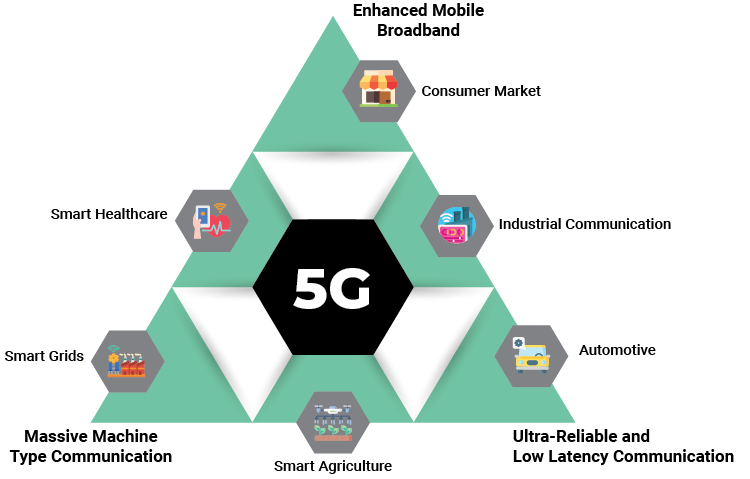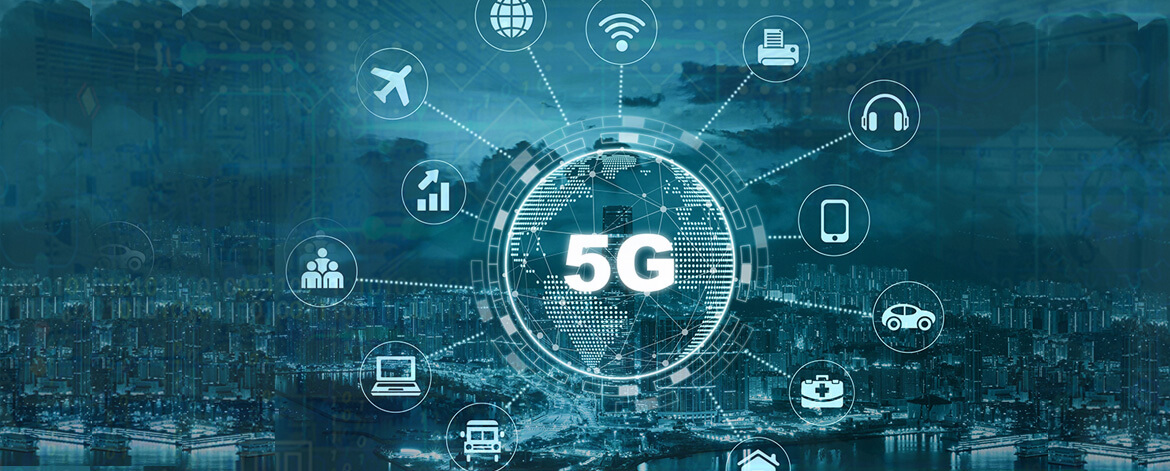The global 5g technology market is expected to reach $667.90 billion by 2026, registering a CAGR of 122.3% from 2021 to 2026.
5G is the latest mobile network, currently being deployed worldwide. With 5G, a major transformative change empowers Service Providers and Enterprises to reshape their business models to launch innovative solutions with 5G connectivity. It is not just the next generation standard in cellular connectivity that would make communication faster and better; with major changes in operating bands, infrastructure, application models, and regulations, it is a paradigm shift that is all set to revolutionize the industry in the upcoming decade. Advancement in 5G technology is driven by multiple wireless connectivity features that can be broadly described by the 5G Triangle.
Broader Classification of the 5G Technology Applications
The 5G applications are mapped into three different classes of use cases offering improvement in key performance parameters of speed & bandwidth, coverage & availability, and latency known as the 5G Triangle.
- eMBB (Enhanced Mobile Broadband): Speeds 10-20 times faster than with 4G
- mMTC (Massive Machine Type Communications): Up to 1 million devices can be connected per square kilometer
- URLLC (Ultra-Reliable and Low Latency Communications): Guaranteed latencies below 10 ms

- The combination of the three 5G classes at different levels has helped to define solutions to many bottleneck problems in diverse application areas finally leading to the ultimate user experience.
Impact of 5G Technology on different Industries
5G is all set to revolutionize the various sectors of the industry by delivering multi-Gbps data speeds, massive network capacity, and ultra-low latency for promising more reliability and increased availability. However, this can only be achieved through the convergence of 5G connectivity development, distributed computing, and the Internet of Things (IoT) services.
5G IoT Application in Consumer Market:
The eMBB is certainly going to play a pivotal role in the initial phases of the 5G rollout as wireless broadband for mobile handhelds and fixed users in remote areas (FWA) is the primary motivation for the evolution of this technology. With additional mmWave support, the 5G CPE is able to offer speed and reliability comparable to fiber. The ever increasing demand for high bandwidth and high data rate for streaming HD videos, SOHO using high data traffic services, and advanced use cases like 3D gaming and augmented reality has brought 5G deployment to a necessity level.
5G IoT Application in Industrial Communication:
Typical industrial applications like robotic production lines, sensor networks, and industrial plant equipment on the shop floor communicate with respective control systems over field buses that generally use a variety of protocols. Performance requirements of these links not able to connect with Wi-Fi or LTE networks. Due to the URLLC feature for 5G, the 3GPP Release-16 specification has introduced distinct 5G enablers for Industry 4.0, industrial IoT (IIoT) that incorporate 5G as a bridge to IEEE TSN, officially includes non-public networks and support for 5G-LAN type service. This is helping industrial designers to develop mobile networks that meet requirements for coverage, time-critical performance, and security aspects to achieve the expected Quality of Service (QoS). The 5G private networks are a preferred choice for industrial communication as high security and privacy requirements can be met through isolation from public mobile networks apart from the advantages of high quality of service and easier maintenance of operations.
5G IoT Application for Automotive – V2X:
The 5GAA group that connects the telecom industry with vehicle manufacturers is working closely to develop end-to-end solutions for a safer automotive ecosystem. The automotive V2X brings in V2I (Vehicle to Infrastructure), V2V(Vehicle to Vehicle), V2N (Vehicle to Network), and V2P (Vehicle to pedestrian) communication. Advanced sensing and computation technologies combined with 5G offering mMTC and URLLC can improve automotive safety and coordinated driving by providing assistance for blind turns on roads, intersections, queue warning, and speed optimization by providing real-time signaling and high definition maps with a latency as low as 10ms.
5G IoT Application in Smart Healthcare:
eMBB and URLLC promised by 5G have opened new avenues for the healthcare industry. With 5G, vital tracking wearables and HD cameras can now meet hard real-time specifications enabling remote streaming consultations and addressing emergencies with no delay. 5G network with edge computing, has made telesurgery possible using robotic arms combined with haptic sensing. The ubiquitous availability of the 5G network has unlocked the additional potential of home healthcare especially for the elder generation allowing care centers to provide real-time monitoring. 5G amends to the existing IoMT ecosystem by enhancing data bandwidth and latency for a better experience with wearables and video streaming
5G IoT Application in Smart Grids:
The recent integration of renewable energy sources like solar and wind power have made the smart grids more complex. In some cases, gas and water are also a part of the smart grid. In the last phase of the grid, due to a massive number of nodes and scattered distribution, the coverage can get very challenging in the last 5km and can be a barrier for grid development and operation. 5G can solve the problem in an inexpensive way by building terminal access networks serving close-knit end nodes. 5G implements network slicing for smart grids dividing into logically isolated networks to meet different service needs with better coverage. The 5G edge computing technology enables distributed gateway deployment to implement local traffic processing and logical computing, which saves bandwidth and reduces latency.
5G IoT Application for Smart Agriculture:
With the 5G mMTC aiming to connect one million devices per square kilometer, the agriculture industry can benefit from a massive amount of interconnected sensors collecting precise data from crops, plants, and livestock. This data can be analyzed and used to control the equipment remotely. With a large amount of distributed sensors for temperature, humidity, pH, light, etc. water-management, and fertilization feed can be optimized to maximize crop yield. Using specialized sensors and cameras, pests, and diseases can be monitored remotely and precise application of pesticides can be done.
About VOLANSYS
VOLANSYS being a one-stop solution provider offers complete product engineering services from conceptualization to manufacturing. With decades of experience and expertise, we offer 5G engineering services and develop connectivity platforms using cellular technologies like GPRS, 3G/4G/LTE. This has helped our clients from diverse industries to transform their businesses into highly productive and extremely reliable models. To understand the VOLANSYS experience and expertise in 5G, let’s read one of the success stories of their US-based client.
Video Streaming Device with 5G Connectivity:
The client is a manufacturer, producing a variety of digital media players for video streaming. They reach out to millions of consumers with their streaming device and provide an incredible TV experience by allowing users to browse through and watch a wide range of video programs. The client wanted to enhance their solution and move one step forward in terms of connectivity. On the same, VOLANSYS helped the client with their experience and capabilities on the 4G/LTE/5G module and integrated with their video streaming device in order to stream high bandwidth media directly using a mobile network. This helped the client in expanding their market reach by enabling them to upsell their solution with cellular connectivity, reducing the dependency on the Wi-Fi network.
Note: The content of this blog is based on the personal knowledge of any research work done by any individuals. The market research report on the wireless charging technology market is used from the website Allied Market Research. Figures are kept to the best of our knowledge and not to mislead in any manner.

About the Author: Abhishek Ashtekar
Abhishek is working with VOLANSYS as Principal Engineer. He has 12+ years of experience working with semiconductor and embedded product companies and has expertise in architecting, designing, and developing solutions focussed on the area of connectivity









